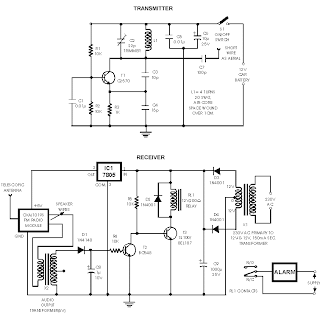Simple Car Wireless Security Alarm
Alarm circuit system is divided into two parts, the transmitter unit and receiver unit. Transmitter unit is working on the range of VHF Band II, exactly at a frequency of 88-108 MHz. This transmitter is a miniature FM transmitter that is installed in vehicles at night while parked in the car porch or car park.
Simple Car Wireless Security Alarm Schematic
The receiver is a single IC-based FM radio module, CXA1019, kept inside. Receiver tuned frequency matches the transmitter. CXA1019 IC is widely available in the market with an affordable price, or you can find replacement parts CXA1191.
How This Car Wireless Secuity Alarm Works
When the transmitter is on and the signals are being received by the FM radio receiver, no hissing noise is available at the output of the receiver. Thus transistor T2 (BC548) does not conduct. This result in the relay driver transistor T3 getting its forward base bias via 10k resistor R5 and the relay gets energized.
When an intruder tries to drive the car and takes it a few metres away from the car porch, the radio link between the car (transmitter) and alarm (receiver) is broken. As a result FM radio module generates hissing noise.
Hissing AC signals are coupled to relay switching circuit via an audio transformer. These AC signals are rectified and filtered by diode D1 and capacitor C8, and the resulting positive DC voltage provides a forward bias to transistor T2. Thus transistor T2 conducts, and it pulls the base of relay driver transistor T3 to ground level. The relay thus gets de-activated and the alarm connected via N/C contacts of relay is switched on.
If, by chance, the intruder finds out about the wireless security alarm and disconnects the transmitter from battery, still remote alarm remains activated because in the absence of signal, the receiver continues to produce hissing noise at its output. So the burglar alarm is fool-proof and highly reliable.
Read more about AA Solar Charger and Auto Battery Charger.

0 comments:
Post a Comment